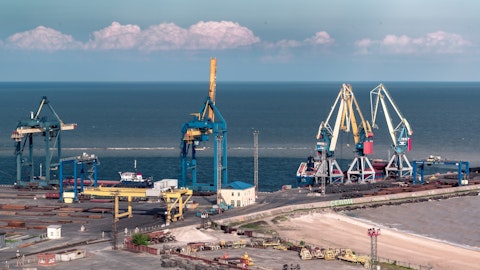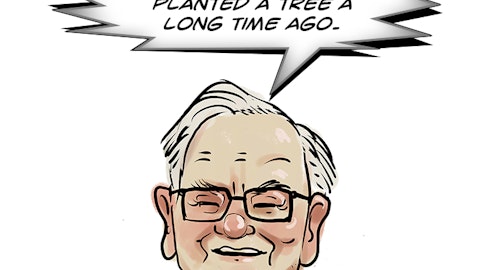Vicki Hollub: I have high confidence that we’ll achieve the $400 million. And some of that we’re already seeing today. And I do believe that we wouldn’t, trust me, we wouldn’t say it if we weren’t pretty confident that we’ll get it.
Sunil Mathew: And John, it’s this confidence that actually helped us increase our cash flow, incremental cash flow from $350 million to $400 million.
John Royall: Fair enough. And then apologies if I miss anything on this, but I was hoping you could get into the 2Q OpEx guide a little bit, which is somewhat flattish with 1Q despite higher production with the GoM back up. So it looks like a numerator issue and not a denominator issue. Just maybe any color there on the OpEx guide.
Vicki Hollub: I think the OpEx guide was driven mostly by the impact of the Gulf of Mexico production and the production coming back on. Yet, I don’t see any differential there.
Sunil Mathew: No, I think that’s right. We’re seeing improvement with Gulf of Mexico production coming back. But again, like I mentioned in my prepared remarks, the second quarter does include some impact from the pipeline outage. And we also have a planned shutdown in Central Gulf of Mexico. So by the time you get to the third and fourth quarter, you should see an improvement in the operating cost.
Richard Jackson: Yes, John, just to add to that trajectory, Q1 actuals were at $10.31 for U.S. LOE, and we’re out looking $10.10 in the second quarter.
Operator: The next question comes from Neal Dingmann with Truist. Please go ahead.
Neal Dingmann: Good afternoon. Thanks for the time. Vicki, my question is on your Permian D&C plans, particularly around slide 24. I like what you’re showing there. You all suggest, I guess, running about 21 rigs this year on average. This is kind of something you talked about after running, I think it shows, was it 24 in the first quarter? And I’m just wondering, trying to get a sense of the cadence, would it just be a sort of typical ramp down? And I’m also wondering if your operational efficiencies continue to be as good as they’ve been, would you let some rigs go and continue kind of with that production plan, or would you maybe just ultimately end up producing more?
Richard Jackson: Yes, perfect. Yes, I appreciate the question. Like I mentioned earlier, the plan is to ramp down just sequentially kind of as we go into the second half of the year. And really that’s been the plan since we poured it and came out. So we are seeing good operational efficiencies. I’d say time to market really in every area is slightly improved. So we’ll consider that as we go into the year to just kind of understand how that may accelerate any capital and how we want to respond to that. I would say one thing that has played out well, we noted these cost improvements. And a couple of things to note, beyond just operational efficiencies, we are seeing some good outcomes as we work with our service providers like frac.
And so we’ve been able to kind of as we relook and hit that more levelized, I’d say, balance and activity in the second half of the year, our utilization is going up about 10% on our frac core. So that’s more pumping hours per year. And that’s both good for us, but also good for our frac providers in terms of how they manage their business. And so those type of things are delivering the savings, which we think will pace well, even with some acceleration in our operational efficiencies. So, as the cadence goes this year, we’re heavy on DNC to start the year and facilities as well. Like I mentioned, and really in that back half of the year, you’ll see that capital drop and you’ll see the production increase. And so looking forward to that. And then that should set us up at a much more level loaded and optimized pace going into 2025.
And so obviously we’ll have options, depending on where Vicki wants to take us with our capital program. But that’s sort of the thinking going into this year and into next.
Neal Dingmann: That’s what I was looking for, Richard. And then, Richard, a quick follow up on the Permian for my second. How do you view the typical, these days you’re doing great on both, but your typical Delaware versus Midland well economics? Why I ask is just looking at the curves you all show on slide 25 and 29, which is, again, I think you’re towards the top. I think you’re showing around 450,000 BOE in the Dale after a year versus around 250,000 in Midland, which again, knowing that they’re cheaper wells, just want to maybe in broad strokes, how you think about the difference in the economics?
Richard Jackson: Yes, I mean, you’re saying it right. I mean, I think, and it’s the same way we think about these primary and secondary benches, even in the Delaware. The cost matters. And it’s not only the drilling and completion costs. You can look at a little bit shallower, a little bit, different drilling in the Midland Basin leading to lower drilling and completion costs. Same for the secondary benches in the Delaware. You get a little shallower into the bone springs, they’re cheaper. And so, certainly you see it play through on the D&C. But the way the teams put together their development areas, they think about the impacts on facility costs. So, one of the examples, I know we had reviewed here recently, we had some shallower bone spring wells that came on, I think, about three years after we drilled the Wolf Camp wells.
And the returns for those secondary wells, even with lower production, was about double the primary. And that was because we were able to reutilize these production facilities. And so, that timing of how you put that production together can make a tremendous impact on the improvement of the economics. And so, as you think about it in basins, we do the same thing. The advantages of being more balanced in the Midland Basin allows us to optimize all these facility costs, maintenance costs, all these things to make sure we’re getting the most production per dollar spent, not just capital, but even OpEx. So, appreciate the question. And that’s absolutely how we look at balancing the capital, looking for that full cycle return forward.
Operator: The next question comes from Scott Gruber with Citigroup. Please go ahead.
Scott Gruber: Yes, good afternoon. Staying on the topic of the Permian, can you provide some color on what’s included in the Permian unconventional inventory count when it comes to the secondary benches in the bone springs? And how does their success potentially push the inventory count higher?





